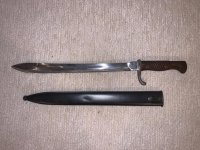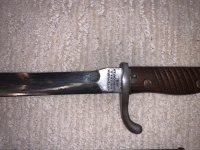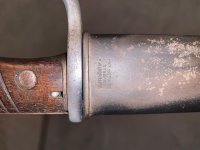Thanks all for responses.
Mine is dated 1917
Following is information I pulled from internet.
"Germany used a wide variety of bayonets on the Mauser Gew-8 and Kar-98 rifles. They entered World War 1 issuing the 1898/05 or ‘Butcher Blade’ model. As the war progressed the shorter blade types and the ersatz models were introduced.
A small percentage of German bayonets were made with a saw back. They were only to noncommissioned officers or pioneer troops.
The Seitengewehr 98/05 has a wood handle and swept back quillon. 14.5-inch single edge butcher blade, marker marked on the ricasso. Dated on top of the blade in front of the crosspiece. Early versions have the saw back as does ours. The saw back was phased out during the war due to negative Allied propaganda. Most had the saw back ground off and re-issued. The first scabbards were leather with steel fittings, followed by all steel.
At the beginning of the Great War, the M1898/05 came with high ears and without flash guard. Pioneers and machine gunner crews used this version because of its suitability to chopping down bushes. The sawback was a favoured tool among German Military units.
The Seitengewehr 98/05 was introduced into the Prussian army in late 1905, as a replacement for the 98/02 for engineers and pioneer troops, as the 98/02 was deemed to long and heavy for it's intended purpose and one and a half times the length of the 1898/05. Initial production was in two versions, the first plain backed, and the second with 29 double teeth. The bayonet, as typical of German blades, did not have more than a vestigial muzzle ring, relying on the length of the hilt mounting to fix the blade to its rifle. The plain back version was identified as the S98/05 or S98/05 o.S. (ohne Säge - without saw) and the saw back as the S98/05 S or m.S. (mit Säge - with saw). About 6% of blades made were fitted with the saw back
At the beginning of WWI it was found that the S98/05 had a problem when used with the Karabiner 98 rifle, the shorter barrel on this model led to burning and damage to the grips as the barrel finished before the vestigial muzzle ring, so in1915 it was decided to fit a steel flash guard (Schutzbleche) to the back of the bayonet to protect the grips. The bayonet was modified by removing most of the muzzle ring remaining, reducing the back of the tang and adding the flash guard.
The sawback version of the bayonet soon became very unpopular on both sides of the frontline. When plunged into the enemy, this style of blade pulled out the victim’s insides when removed causing exceptional pain, suffering and inevitably death. It was communicated to the German army that French and British soldiers would torture and then killed their troops if found with a sawback blade on their bayonet. Therefore an order was issued in 1917 that all sawbacks be removed from service.
As the sawback blades had been used for cutting wood and wire fence posts, with the reissue of ground down blades, NCOs were also given wire saws. By the end of WWI the 84/98 was taking over as the primary bayonet for the German troops, and production of the s98/05stopped. Large numbers of the blades were shipped to Turkey, Poland, and Yugoslavia for use by their national armies. Between the wars the 98/05 was issued to specially identified troops as a mark of distinction or honour. The peace treaty restricted the numbers of weapons allowed to the German army and as such, 1920 authorised blades were stamped with 1920 on the cross guard indicating the official use by the Weimar republic.
The version of the S98/05 which we have on display in our museum here at Armourgeddon is stamped W17 indicating its fabrication in 1917. It has a fully intact sawback blade and discolouration on the metal indicating its use in armed conflict. The scabbard or case which holds the bayonet when not in use, is the latterly manufactured metal version as opposed to being made of leather. It is embossed with the same wording as the blade itself; Waffenfabrik, Mauser A.G. Oberndorf a.N.
Photographs accompanying this blog show details of the actual bayonet here on display and also a picture of the high ears of earlier versions of the blade and guard.
There are many weapons, artifacts and memorabilia of the Great War and WWII in the museum at Armourgeddon. A trip around our museum is a great day out for the military enthusiast- even better when paired with an experience of driving tanks around our WWII bombing range?



